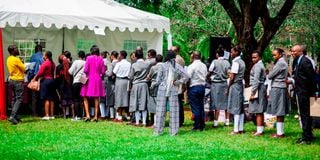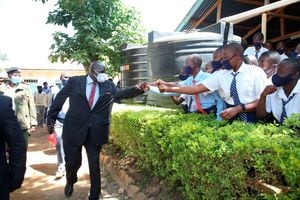
Parents, guardians and students queue during the Form One admission exercise at Kenya High School in Nairobi on January 15, 2024.
Over-enrolment in a number of public schools has stretched basic facilities at the institutions to the limit, exposing learners to risks that have at times resulted in fatalities, Nation can reveal.
A Nation survey across the country shows many schools have flouted the Ministry of Education’s health and safety guidelines due to a shocking lack of checks by its Quality and Assurance Department. Classrooms and dormitories are congested while inadequate sanitation facilities pose health risks, with the issue prevalent in low-income settlements in urban areas.
Some classes seen by Nation have 200 learners, well above the recommended 45 by the United Nations Educational and Scientific and Cultural Organisation, compromising learning. Cases of indiscipline may also arise because it is difficult to manage many students with inadequate staff. During breaks, learners are forced to queue at the few washroom facilities available while some boarders go for days without bathing.
Mwihoko Road which leads to Kimbo from Githurai is ever busy with vehicular and human traffic. Mwiki Road branches off it and leads us to Mwiki Primary School, tucked between residential and commercial buildings in the expansive Githurai area.
When classes are on, it’s unassuming facade hides the over 5,000 pupils crammed in its one-acre compound. However, at break time or at the end of the school day, the learners pour forth in a shock of orange sweaters and grey tunics. The voices of thousands excited children assail the neighbourhood in a steady din like the roar of an ocean.
The school made national news in 2021 as learning resumed after the Covid-19 lockdown and the Ministry of Education came up with guidelines to contain the spread of the virus. However, social distancing was one of the measures that proved impossible at Mwiki Primary School due to congestion. The little space in the middle of the storeyed blocks can hardly be described as a playground and only a few learners can use it at a time.
During a sitting of the Education Committee of the National Assembly last year, Kiambu Woman Representative Anne Muratha described the school as a disaster waiting to happen. The school sits close to the border of Kiambu and Nairobi counties but on the Kiambu side. It has 37 permanent classrooms and 10 semi-permanent ones for use by junior school learners. The learners share 60 toilets.
“There are no other public primary schools in this area, so most parents bring their children here because we can’t afford the fees paid in private schools. However, the school also performs well in national examinations,” Ms Jane Wangeci told Nation.
Ruiru MP Simon King’ara, whose constituency hosts the school, told Nation plans to move some pupils have not been successful since its nearest neighbours, Kimbo and Kwa Ng’ethe, are also congested with 3,700 and 2,000 learners respectively.
Education Cabinet Secretary Ezekiel Machogu said the government is making plans to address the congestion at the school.
“We are planning to move it to another place with enough space to accommodate all the children,” the CS told Nation.
Ndurarua Primary School in Kawangware, Dagoretti South Constituency, faces a similar problem. Its 6,000 learners are more than the school can host. A notice at the gate announced that new admissions have been closed.
“Something needs to be done about the congestion. You find four or five children sharing a desk,” Ms Caroline Chebet, a parent at the school, told Nation. She transferred her Grade Three daughter to the school from a private institution this year. All classes have over 100 learners.
Principals, through the Kenya Secondary Schools Heads Association (Kessha) said they are grappling with congestion due to the 100 percent transition policy. Kessha national chair and Murang’a High School principal Willy Kuria said the situation is worse in boarding schools.
“Facilities like the library have been turned into dormitories to accommodate students,” he said.
At Lions High School in Kisumu County, the student population stands at 2,200 and teachers have resorted to conducting some of the classes under trees. The principal, Ms Eudiah Oyier, said learners are forced to share the few sanitation facilities, which could compromise their health. The school relies on 36 latrines to serve its huge population.
She said that whereas all the learners who have been admitted to the institution are yet to report, the school is already struggling to cater for the needs of those who have reported.
Kenya Union of Post Primary Education Teachers (Kuppet) Kisumu branch secretary Zablon Awange said a biting shortage of teachers has affected the quality of education.
Kakamega School has an enrolment of 3,030 and the management has had to improvise to deal with the congestion. The school has eight new classrooms, two 360-capacity new dormitories with modern washrooms and a new separate urinal block to address queues that would consume learning hours.
The principal, Dr Bahati Mambili, said they have installed a bio-digester as a long-term solution to waste management. It recycles waste to produce biogas, which supplies energy to the teachers’ quarters.
At St Peters’ Boys High School in Mumias, a multi-purpose hall has been converted into a dormitory. The principal, Mr Chrispinus Owino, said the school is building two new dormitories.
The principal of Asumbi Girls High School in Rangwe, Homa Bay County, Ms Linet Sati, told Nation she has over 3,000 students. For games, the learners use the field at Asumbi Teachers Training College.
“We have also ensured that there are enough sanitation facilities both at the learning areas and at the dormitory,” she said.
Tenwek Boys’ High School in Bomet County has a population of 3, 190 with the Form One admission this year standing at 1,300. A makeshift dining hall has been erected while temporary hostels have been put up even as permanent ones are still under construction.
Reporting by David Muchunguh, Winnie Atieno, Elizabeth Ojina, Angeline Ochieng, Shaban Makokha, George Odiwuor, Kassim Adinasi and Vitalis Kimutai










